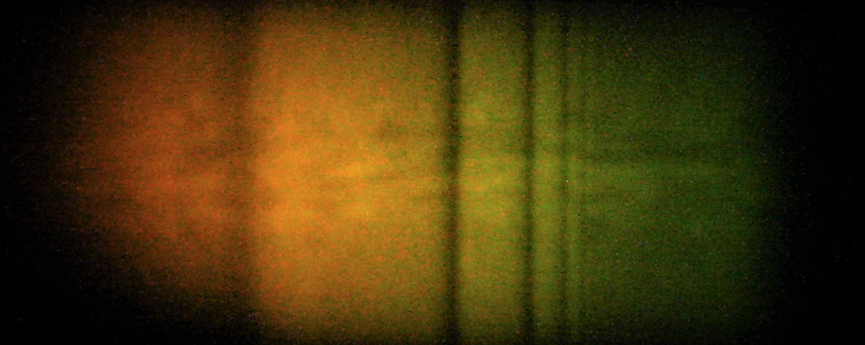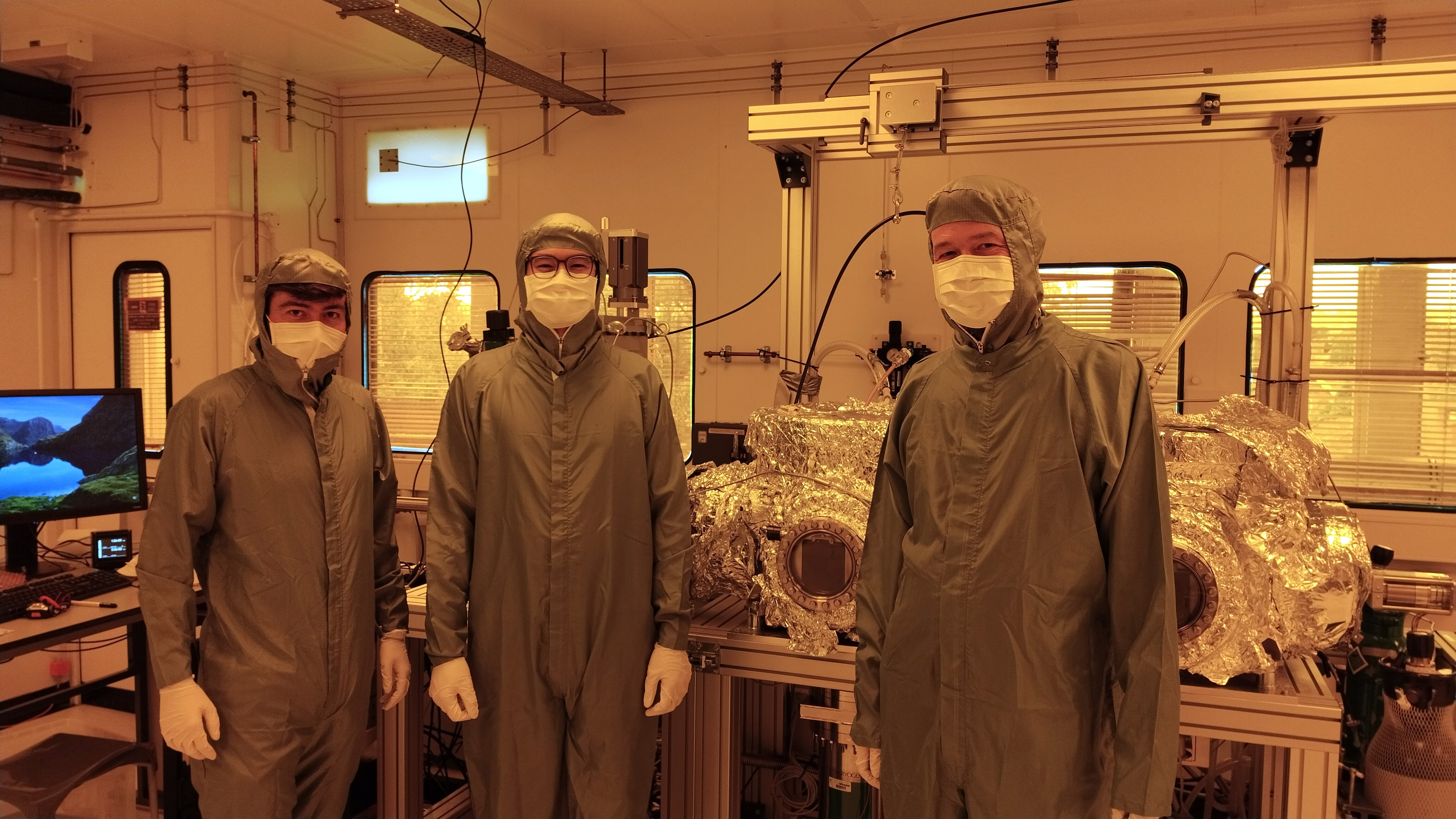Excitons
Excitons are atom-like particles which are found in bulk semiconductors. They are formed of an electron and a hole which are bound together by a Coulomb potential. As they are a bound state of a positive and negative charge, they are analogous to hydrogen atoms, and share a similar ladder of energy levels. An exciton spectrum can be seen in the image below, where each dark line is a different exciton resonance. The similarities with an atomic system is immediately apparent in this image from looking at the patterns of these spectral lines. Our studies focus on the highly excited states on the right hand side of the image, known as Rydberg excitons.

Spectrally resolved photo of the exciton spectrum.
Cuprous Oxide
 Natural cuprous oxide gemstone.
Natural cuprous oxide gemstone.
Our experiments are performed on the semiconductor Cu2O, which is the red gemstone below. Rydberg excitons are incredibly sensitive to their environment, and so very pure crystals must be used. Currently, the highest purity crystals are natural gemstones, but one avenue of our research is to explore the growth of high-purity syntehtic material, through collaborations with Cardiff University.
Microwave-optical Coupling

Exciton spectrum showing quantum number states as high as 16.
The high lying Rydberg excitons show many exaggerated properties compared to ground state excitons. Crucially, the dipole-moment associated with transitions between Rydberg states scales with the principal quantum number squared, leading to interactions between excitons and as well as other nonlinear effects. In our experiments we use a microwave field to couple neighbouring Rydberg exciton levels, directly exploiting the large dipole moment associated with these transitions. As we create our Rydberg states through optical excitation with a laser, we have a system which can form the basis of a microwave-optical converter. One of our aims is to create a high-bandwidth and high-efficency microwave-optical converter. To acheive this, one of our current projects is looking at creating a hybrid quantum system consisting of cuprous oxide and a superconducting microwave resonator.

Our recent visit to the University of Cardiff
Apply Now!
If you are interested in joining the team or finding out more, please contact m.p.a.jones@durham.ac.uk.
Team members
Prof. Matthew Jones (Principal investigator)
Prof. Stuart Adams (Co-investigator)
Dr. Liam Gallagher (Reseracher co-investigator)
Qin Xi (Horatio) Wong (PhD student)
Madeleine Fisher (PhD student)
Former members
Dr. Alistair Brewin (Former PhD student)
Dr. Jonathan Pritchett (Former PhD student)
Dr. Joshua Rogers (Postdoctoral Research Assistant)
Collaborators
Cardiff University
Prof. Stephen Lynch
Prof. Wolfgang Langbein
Prof. Simon Doyle
University of St Andrews
Publications
[1] Microwave-optical spectroscopy of Rydberg excitons in the ultrastrong driving regime
Brewin, A., Gallagher, L. A., Pritchett, J. D., Wong, H. Q., Potvliege, R. M., Clark, S. J., & Jones, M.
New J. Phys. 26 113018 (2024)
[2] Giant microwave–optical Kerr nonlinearity via Rydberg excitons in cuprous oxide
Pritchett, J.D., Gallagher, L.A., Brewin, A., Wong, H.Q., Langbein, W., Lynch, S.A., Adams, C.S. and Jones, M.
APL Photonics 9 (3): 031303 (2024)
[3] Microwave-optical coupling via Rydberg excitons in cuprous oxide
Gallagher, L., Rogers, J., Pritchett, J., Mistry, R., Pizzey, D., Adams, C., Jones, M., Grünwald, P., Walther, V., & Hodges, C.
Phys. Rev. Research 4, 013031 (2022)
[4] High-resolution nanosecond spectroscopy of even-parity Rydberg excitons in Cu 2 O
Rogers, J., Gallagher, L., Pizzey, D., Pritchett, J., Adams, C., Jones, M., Hodges, C., Langbein, W., & Lynch, S.
Phys. Rev. B 105, 115206 (2022)
[5] Rydberg excitons in synthetic cuprous oxide Cu 2 O
Lynch, S., Hodges, C., Mandal, S., Langbein, W., Singh, R., Gallagher, L., Pritchett, J., Pizzey, D., Rogers, J., & Adams, C.
Phys. Rev. Materials 5, 084602 (2021)
PhD Theses
Jon Pritchett: Microwave Induced Optical Nonlinearities in Cuprous Oxide (2023)
Liam Gallagher: Optical and microwave spectroscopy of Rydberg excitons in Cu $ _2 $ O (2022).